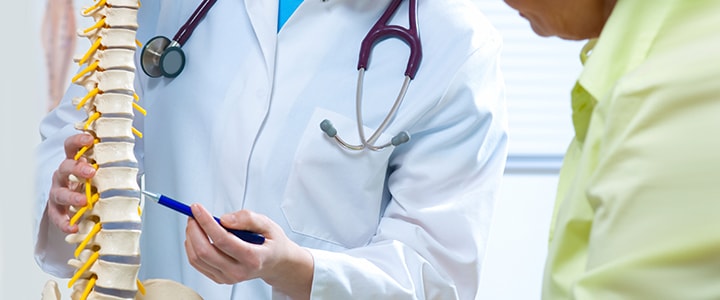Chiropractic

A system of diagnosis and treatment based on the concept that the nervous system coordinates all of the body's functions, and that disease results from a lack of normal nerve function. Chiropractic employs manipulation and adjustment of body structures, such as the spinal column, so that pressure on nerves coming from the spinal cord due to displacement (subluxation) of a vertebral body may be relieved. Practitioners believe that misalignment and nerve pressure can cause problems not only in the local area, but also at some distance from it. Chiropractic treatment appears to be effective for muscle spasms of the back and neck, tension headaches, and some sorts of leg pain. It may or may not be useful for other ailments.
Modern chiropractic was founded by Daniel David Palmer, a grocer, who performed his first chiropractic adjustment in 1895. The term "chiropractic" derived from the Greek "chir-" referring to the hand + "prassein", to do = to do with the hands (to manipulate) dates to 1898, the year Palmer founded the Palmer College of Chiropractic in Davenport, Iowa.
Chronic Back Pain
There are numerous reasons why individuals develop chronic back pain. In addition to the progression of chronic pain sited above, chronic low back pain may also include, but is not limited to old injuries, weak muscles, daily sitting, joint mechanical problems, lifting/twisting and acute injuries. Over time, along with the aging process, aberrant joint movement causes degeneration of the discs and joints contributing to pain, stiffness and nerve damage.
The pain, aberrant joint movements and muscle weakness causes the body to go into protective torsions. The examination that is done at the Advanced Therapeutic Centre, identifies specifically the degree of these body torsions and our manual therapy effectively corrects them. In addition, at the Centre we use a special Dynamic Flexion Traction Unit which gently elongates the vertebral column. This helps to restore proper function to the joints, which in turn relieves the irritation of the nerves and decreases the pain.
Lower Back Pain – Laser to the Rescue
Dr. Don Fitz-Ritson, DC., FCCRS(C). A few years ago, X was referred to me by one of my patients. X was suffering with intense low back pain and had difficulty sitting, due to a herniated disc which caused radiating pain down his leg to his heel. X had tried other treatment programs to no avail. X wanted to know if I could provide him some degree of pain relief, until he had surgery in eight weeks.
I remember when X came into my office. He could not sit, or even stand still. His continuous movement around my office cause me to get very nervous. I began to question myself. Could I really help him? The examination I was able to do provided me with the information I needed to make sure that my treatment program would not do any further harm. X was able to lie on the treatment table quietly for about five minutes. This allowed me time to apply the laser and gentle traction to his low back area.
After the treatment, X took about five minutes to get off the treatment table, but when he stood up, he noticed that the "edge" of the pain was decreased. I then placed a special "pelvic belt" on X and told him to ICE the area regularly at home.
On X's next visit, he was able to stand quietly while telling me that the pain in his back and down the leg was indeed more bearable. I explained the treatment program to X and mentioned that I would endeavor to relieve as much pain as possible until his surgery. I also mentioned that as the pain subsided, I would provide him with some specific exercises for strengthening the muscles in the low back. These strong back muscles would also help his back recover quicker, post surgery.
After six treatments, X had 70-75% pain reduction and questioned me regarding the need for surgery. I suggested that he obtain an appointment with his Orthopedic Surgeon and discus his concerns. At this point, I did further tests of X's back muscles, and introduced specific exercises to begin strengthening the weakest ones.
X saw his Orthopedic Surgeon after his tenth visit with me. At this time he had approximately 90% pain reduction in his low back and no pain in his leg. He was able to sit for longer periods and easily got off the treatment table. The Orthopedic Surgeon was pleased with X's progress and told him that he did not need surgery at this time. He advised him to continue doing what he was doing and gave him an appointment in 4 weeks.
X was happy, but I was not prepared for the next question. Because he was nearly pain free, and feeling stronger due to his exercises he was doing, he wanted to know if he could play golf with the boys. I had explained to X the weaknesses he has in his back muscles and the effects of twisting and turning movements on the herniated disc. Every visit was the same question. So I advised him to go to the golf course, wear his "pelvic belt" and hit balls for 30-60 minutes. If there was any pain, he should stop immediately.
X gradually began playing golf and we increased the intensity of the exercises for increased back strength. On X's visit to the Orthopedic Surgeon, he was pain free and he was discharged.
This was a happy ending for X and his herniated disc. X was young and he followed the advice he was given. Not all herniated discs I see end with this happy way. But all should go through the route of good alternate care prior to surgery. Maybe a few surgeries could be prevented, maybe for some, the back muscles could be better prepared before surgery. This would be a definite advantage for post surgical rehabilitation.
Chronic Pain Relief
